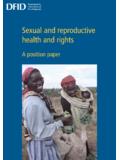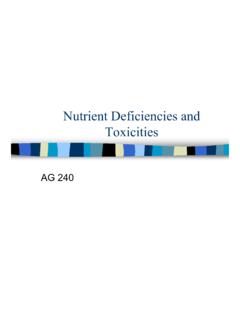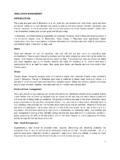Transcription of The Importance of a Life Course Approach to Health ...
1 1 The Importance of a Life Course Approach to Health : Chronic Disease Risk from Preconception through Adolescence and Adulthood Chandni Maria Jacob 1, Janis Baird 2,3, Mary Barker 2,3, Cyrus Cooper 2,3 and Mark Hanson 1,3 1 Institute of Developmental Sciences, University of Southampton, Southampton S016 5YA, United Kingdom 2 MRC Lifecourse Epidemiology Unit, University of Southampton, Southampton SO16 6YD, United Kingdom 3 National Institute for Health Research Southampton Biomedical Research Centre, University Hospital Southampton.
2 NHS Foundation Trust, Southampton SO16 6YD, United Kingdom 2 Table of Contents The Importance of a Life Course Approach to Health : Chronic Disease Risk from Preconception through Adolescence and Adulthood .. 1 Synopsis .. 4 1. Introduction .. 4 2. The life Course Approach to Health .. 5 What is a life Course Approach ? .. 5 Origins of life Course epidemiology .. 5 Conceptual models in life Course epidemiology .. 6 The critical period model .. 7 The critical period model with later effect modifiers.
3 7 Accumulation of risk model/Cumulative model .. 9 Pathway model/Chain of risk model/Trigger model .. 9 Other conceptual models in life Course epidemiology .. 9 A new model based on the pathways model .. 10 Healthy ageing .. 12 Common concepts in life Course epidemiology: .. 12 3. Risk factors for NCDs across the life Course .. 13 Constitutional and biological factors: genetics and epigenetics .. 13 Contextual factors affecting Health and well-being throughout the life Course .. 14 Behavioural factors.
4 14 Environmental factors .. 17 Psychosocial factors .. 17 4. Key stages of the life Course affecting Health and 18 Before birth .. 18 Fetal development .. 18 Preconception .. 19 Pregnancy .. 20 Newborn and early childhood .. 21 Childhood .. 22 Adolescence .. 23 Adulthood .. 23 Ageing .. 24 3 5. Application of the life Course Approach to the adolescent age group .. 25 Factors influencing Health and well-being in adolescents .. 25 Biological development .. 26 Onset of risky behaviours.
5 26 Psychosocial determinants .. 27 Genetic and epigenetic influences .. 27 Environmental factors .. 28 Concerns in the adolescent 28 Reproductive and sexual Health .. 29 Obesity .. 29 Substance abuse .. 30 Mental Health and suicide .. 30 Scope for action .. 30 Prevention of teenage pregnancy and services for sexual and reproductive Health .. 31 Preventing obesity and achieving optimum nutrition and physical activity during adolescence .. 32 Other interventions for common risky behaviours in adolescence.
6 33 Conclusion .. 34 References: .. 34 4 Synopsis Non-communicable diseases (NCDs) including obesity, diabetes and cardiovascular disease, musculoskeletal, mental and neurological disorders have been identified as the world s largest killers , and multiple major international organizations have stressed the Importance of adopting a life Course Approach to address them. The life Course concept recognizes the opportunity to prevent and control diseases at key stages of life from preconception through pregnancy, infancy, childhood and adolescence, through to adulthood.
7 This does not follow the model of Health where an individual is healthy until disease occurs. The trajectory is determined earlier in life, and evidence suggests that age related mortality and morbidity can be predicted in early life with factors such as maternal diet and body composition (before and during pregnancy), low childhood intelligence, adverse childhood experiences acting as antecedents of late-life disease. A life Course perspective enables the identification of a high-risk phenotype and markers of risk early, supporting current efforts for primary prevention of NCDs by providing timely interventions in early life.
8 Part 1 of this paper summarizes existing models that explore the influences of the life cycle on chronic disease. Part 2 is a scoping review of risk factors of NCDs through the life Course , highlighting issues in key life stages, with a special focus on the adolescent age group. Studies based on Developmental Origins of Health and Disease (DOHaD) have shown the transgenerational nature of NCD risk, and called for the need to attain optimum Health in the preconception period.
9 Multiple life-long Health behaviours are established during adolescence making it an important stage for intervention. 1. Introduction Over the past century, changes in patterns of mortality globally have included a reduction in infectious disease mortality and an increase in chronic non-communicable diseases (NCDs).1 Though this shift started in high-income countries, there is now a double burden of NCDs and communicable diseases on the low- and middle-income countries.
10 Mortality due to NCDs mainly cardiovascular diseases and diabetes is projected to rise along with the economic and social development in these The risks for NCDs are also changing due to demographic shifts, changing patterns of diet, physical activity, alcohol and tobacco High blood pressure, high plasma glucose, obesity and overweight are some of the leading risk factors for non-communicable diseases, and thus improving nutrition is essential to improve Health Attention has recently shifted from adult lifestyle and risk factors as a cause for NCDs to early life experiences that influence adult Health and mortality The 2030 Sustainable Development Goals (SDGs) promote commitment to Health through the goal Ensure healthy lives and promote well-being for all at all ages.












